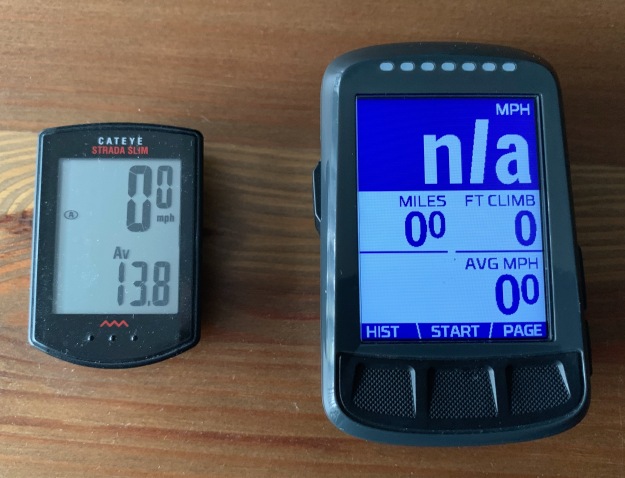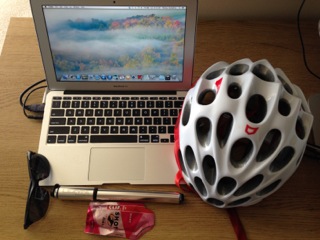
The Cateye Strada on the left, and the Wahoo Elemnt Bolt on the right.
A bike computer is a curious device for a number of reasons. It’s a training tool, a source of information when riding, and as I’ve often said, a taskmaster. When I was a child, I didn’t need one. A few years ago life put me in a difficult place. I was recently divorced and I was hurting. I had moved back to my old college stomping grounds in the Washington DC area to start over, and I knew that if I didn’t find something to keep me busy, I was going to slide into depression. Depression wasn’t a matter of if, but when. I loved cycling and reached out to an old friend to get some advice. As a result, I got involved in my local cycling club, and I got some good gear recommendations, including this: buy a computer.
A little background…
At the time, the GPS computer was in it’s infancy, a large and curious device that was expensive and even a bit exotic. I didn’t even consider one. What little research I did led me at first to a wired Cateye Enduro model. It had more functions than I actually used, but it was reliable. It looked awful with a wire wrapped around my brake cable and down the fork, but at the time, (2005) that seemed to be fairly common. It wasn’t long before I went wireless though, buying another Cateye product – the Strada – that I liked so much I bought one for my Orbea Onyx in 2010 and my Cannondale CAAD 12 in 2015. These were simple things that did everything I needed. They told me my speed, and the distance I’d gone, average speed, the time I’d spent moving, the maximum speed on my rides, and it included an odometer that was really only of use since the last battery replacement. It had all I needed to follow the average que sheet – the ride directions on paper that I clipped to my bars or stem. Information storage was a notebook. I wasn’t as accurate as I could have been, and my yearly mileage totals were only approximate, but they were fine. I didn’t feel the need to spend money to get the latest and greatest. I have an unusual facility for remembering routes. It is very hard for me to get lost in a place I’ve already been. Given this innate gift of navigation, I never felt the need to get more from a bike computer. I finally gave in to the GPS revolution when I started my passion project late last year. This season, most of my riding has been done with a GPS computer on my bars. I didn’t want everything available in a GPS, because I didn’t use everything I already had. My research led me to the Wahoo Elemnt Bolt. I have heard people complain about it’s competitors, but never the Bolt. I’ve come to understand why. Now that I’ve had it for nearly a year, it’s time I wrote about my experience with this technology.
The Wahoo Elemnt Bolt
Apart from wanting to give Wahoo more examples of the letter “e” to use in their unit names, I found the Bolt to be an excellent computer. The most important thing is the unit’s ease of use. Most of the controls are found on a smartphone app, and the buttons on the unit itself are easy to access, even when wearing gloves. The 2.2″ screen is black and white – which can be a bother to some, but I find it easy to read. The newer Wahoo units, such as their Roam, make limited use of color, and I think that’s a nice addition, but not strictly necessary. However, like most features of the modern GPS unit, familiarity with color on my computer might just change my mind. The screen has good contrast and the controls for backlighting the display are easy to find and use.
The on/off button is on the left side of the unit, the two buttons on the right side change the size of the information displayed on the unit to show more or less information, and also to scroll through menus. The three buttons on the front allow access to other menus and features such as the mapping display.
At the top of the display is a row of LED lights that can be configured to alert you to various things. They show me if I’m riding above or below my average speed, and they flash if I’ve gone off course. When you get back on course, the unit resumes the route seamlessly. I’ve found this through short cuts or route changes this year, and I could ignore the lights, knowing where I was. Even so, I think this is an excellent feature if you’re riding somewhere you aren’t familiar with, and you wander off course.
The unit can display a map, which shows the route using arrows. The maps can be added to the unit according to where you live or travel, and they are updated automatically through the application. I don’t use the map feature much, but I have found it easy to follow when I have.
What you choose to display is controllable from the companion app on your phone. If you have speed and cadence sensors, a heart rate monitor, or a power meter, all of those sensors can be connected via the app and displayed on the Bolt. The genius of the unit is the phone app. It lets you set what to display and in what order to display it. Rather than trying to find controls on the unit, most of the work is done on your smartphone, including pairing with the unit and sensors. Downloading routes is simple in the application, and synchronizing with the unit is easy, as is selecting a route. You can turn the unit on, ride where you like and save the route. The best part is that when you’re done riding, it automatically uploads your ride information to the apps you use, in my case Strava and Ride with GPS. If you don’t have WiFi available when you finish, sync the unit with the Wahoo app when you get home, and your ride will be uploaded. Now Strava keeps my ride data, and I’ve come to like having all the data it collects.
Strava – catnip for competitive riders
Strava is an application that I have been aware of – and wary of – for years. Stories of people having accidents because they were chasing personal records or racing to be the fastest on a particular segment have been circulating for a long time. Ways to cheat Strava have popped up, and such stories kept me away from using a GPS and tracking ride data because I’m competitive by nature and I know that these aren’t things that I can ignore. I stepped over to the “dark side” though, and to my surprise, I’ve learned to stop worrying and love Strava. (Yes, that was a thinly veiled “Dr. Strangelove” reference.) Early on I chased segments and personal bests on local rides from home, but a funny thing happened after a few months – I stopped chasing personal bests. This isn’t to say I didn’t care. I will look at my feed after a ride to see how I did, particularly if I felt good or fast that day. But while I did start out by identifying segments where I thought I could go for a personal best when I started using Strava, after the novelty wore off, so did my desire to chase segments, or at least to pay attention to them and plan what to chase. On the usual routes that I ride on weekday evenings, I know where the segments are. If I’m feeling good, every so often I’ll go for a personal best, or at least sprint a segment to see what happens. More often I’ll look at a ride after it’s been uploaded and discover that I had a personal best that I hadn’t actually been trying for.
While I thought Strava would appeal to my competitive nature, what I found was that after years of riding without such data, I didn’t actually compete with myself over segments, and I use it to get a feel for my fitness level. I track miles, I look back over rides and show friends where I’ve gone. I understand the drive to use Strava to compete with yourself and others. I thought that I would do that too, but I didn’t. I was tempted. I just found that I didn’t want to race. When I’m in the mood, I go for it, but I’ve taken a more practical approach than I thought I would. Strava is a tool, and how you use a tool is not the choice of the tool. So I’ve come to see Strava as a good way to keep information, while understanding how it gives competitive people an outlet for their drive. Maybe it’s an advantage of age – I’ve found Strava at the right time to avoid being obsessive about it.
